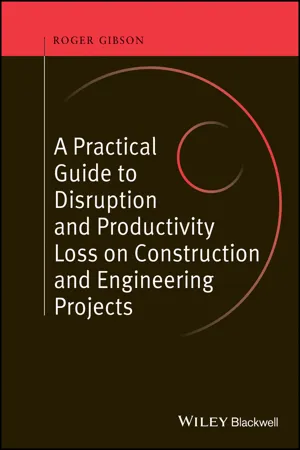
A Practical Guide to Disruption and Productivity Loss on Construction and Engineering Projects
- English
- ePUB (mobile friendly)
- Available on iOS & Android
A Practical Guide to Disruption and Productivity Loss on Construction and Engineering Projects
About this book
Disruption of a construction project is of key concern to the contractor as any delay to the project will involve the contractor in financial loss, unless those losses can be recovered from the employer. It is, however, acknowledged that disruption claims in construction are difficult to prove, usually the result of poor or inaccurate project records, but the cost of lost productivity or reduced efficiency to the contractor under these circumstances is very real.
Practical Guide to Disruption and Productivity Loss on Construction & Engineering Projects is clearly written to explain the key causes of disruption and productivity loss. Disruption claims rest on proof of causation, so it discusses the project records that are necessary to demonstrate the causes of disruption, lost productivity and reduced efficiency in detail. Quantification of a disruption claim in terms of delay to activities and the associated costs are also fully discussed. With many worked examples throughout the text, this will be an essential book for anyone either preparing or assessing a disruption and loss of productivity claims, including architects, contract administrators, project managers and quantity surveyors as well as contractors, contracts consultants and construction lawyers.
Frequently asked questions
- Essential is ideal for learners and professionals who enjoy exploring a wide range of subjects. Access the Essential Library with 800,000+ trusted titles and best-sellers across business, personal growth, and the humanities. Includes unlimited reading time and Standard Read Aloud voice.
- Complete: Perfect for advanced learners and researchers needing full, unrestricted access. Unlock 1.4M+ books across hundreds of subjects, including academic and specialized titles. The Complete Plan also includes advanced features like Premium Read Aloud and Research Assistant.
Please note we cannot support devices running on iOS 13 and Android 7 or earlier. Learn more about using the app.
Information
Chapter 1
Introduction
1.1 Introduction
1.2 The aims of this book
- Chapter 1 Introduction: details general principles relating to extensions of time, delay claims and the SCL Protocol.
- Chapter 2 Contracts and Case Law: looks at the relevant loss and expense clauses in the JCT and NEC contracts, plus case law concerning disruption, loss of productivity, mitigation and acceleration.
- Chapter 3 Programmes and Record Keeping’: deals with the fundamental matter of the project programme, together with the important matter of record keeping during the project.
- Chapter 4 Delay and Disruption: looks at the fundamentals of these two issues.
- Chapter 5 Loss of Productivity: included in this chapter are examples of two techniques to demonstrate disruption and productivity loss.
- Chapter 6 Acceleration and Mitigation: this final chapter looks at the fundamentals of these two issues.
- Appendix 1: Definitions and Glossary.
- Appendix 2: Standards for the Levels of a Programme or Schedule.
1.3 Appendix 3: Society of Construction Law: Delay & Disruption Protocol (October 2002) The SCL Protocol
- Programme and records: To reduce the number of disputes relating to delay, the Contractor should prepare and the Contract Administrator (CA) should accept a properly prepared programme showing the manner and sequence in which the Contractor plans to carry out the works. The programme should be updated to record actual progress and any extensions of time (EOTs) granted. If this is done, then the programme can be used as a tool for managing change, determining EOTs and periods of time for which compensation may be due. Contracting parties should also reach a clear agreement on the type of records that should be kept.
- Concurrent delay – its effect on entitlement to compensation for prolongation: If the Contractor incurs additional costs that are caused both by Employer Delay and concurrent Contractor Delay, then the Contractor should only recover compensation to the extent it is able to separately identify the additional costs caused by the Employer Delay from those caused by the Contractor Delay. If it would have incurred the additional costs in any event as a result of Contractor Delays, the Contractor will not be entitled to recover those additional costs.
- Identification of float and concurrency: Accurate identification of float and concurrency is only possible with the benefit of a proper programme, properly updated.
- Mitigation of delay and mitigation of loss: The Contractor has a general duty to mitigate the effect on its works of Employer Risk Events. Subject to express contract wording or agreement to the contrary, the duty to mitigate does not extend to requiring the Contractor to add extra resources or to work outside its planned working hours. The Contractor’s duty to mitigate its loss has two aspects – first, the Contractor must take reasonable steps to minimise its loss; and secondly, the Contractor must not take unreasonable steps that inc...
Table of contents
- Cover
- Title page
- Table of Contents
- Preface
- Acknowledgements
- Chapter 1: Introduction
- Chapter 2: Contracts and Case Law
- Chapter 3: Planning, Programmes and Record Keeping
- Chapter 4: Delay, Disruption and Causation
- Chapter 5: Loss of Productivity
- Chapter 6: Acceleration and Mitigation
- Appendix 1: Definitions and Glossary
- Appendix 2: Standards for the Levels of a Programme or Schedule
- Appendix 3: Society of Construction Law
- Index
- Also Available from Wiley Blackwell
- End User License Agreement